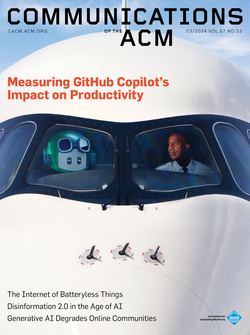Communications of the ACM
DEPARTMENT: Departments
DEPARTMENT: Editor's Letter
DEPARTMENT: Career Paths in Computing
DEPARTMENT: BLOG@CACM
COLUMN: News
COLUMN: Opinion
COLUMN: Legally Speaking
COLUMN: Privacy
COLUMN: The Profession of IT
COLUMN: Opinion
SECTION: Practice
SECTION: Research
SECTION: Research Highlights
COLUMN: Last Byte
What Do Computing and Economics Have to Say to Each Other?
A culminating chapter in the information revolution is the development of computing and communication technologies in the 20th century, where we learned to transmit as well as process information.DEPARTMENT: Editor's Letter
Corrigendum for February 2024 Article
In the February 2024 Communications article titled, "Energy and Emissions of Machine Learning on Smartphones vs. the Cloud," the authors found and corrected two arithmetic errors after it was printed. The following is a detailed …DEPARTMENT: Career Paths in Computing
Computations for This World and out of This World
In many ways, my career has been chasing chances to do mathematics.DEPARTMENT: BLOG@CACM
Pondering the Ugly Underbelly, and Whether Images Are Real
Robin K. Hill teaches how proofs lead to the truth, while Carlos Baquero searches for truth in imagery.COLUMN: News
Service Robots Roll Forward
Transitioning from classic 'programmed automation' to modern 'AI-powered autonomy.'The Battle to Mitigate E-Waste
As electronic waste grows by the metric ton, companies and citizens work to stem the tide.What's That Smell?
Digital scent technologies bring aromas to virtual reality.In Memoriam: Niklaus Wirth
The overriding philosophy of computing pioneer Niklaus Wirth, who died on January 1, 2024, was that systems should be simple, efficient, and "elegant."COLUMN: Opinion
Innovation Is Overrated: A Provocation
Digital innovation is not working in the interest of the whole of society. It is time to radically rethink its purpose without sacrificing the benefits it entails.COLUMN: Legally Speaking
U.S. Copyright Office's Questions about Generative AI
Generating more questions than answers.COLUMN: Privacy
Internet of Things Security and Privacy Labels Should Empower Consumers
Designs should offer useful information and convenience.COLUMN: The Profession of IT
Can Machines Be in Language?
Large language models brought language to machines. Machines are not up to the challenge.COLUMN: Opinion
Disinformation 2.0 in the Age of AI: A Cybersecurity Perspective
Why disinformation is a cyber threat.Generative AI Degrades Online Communities
How large language models are influencing online communities.SECTION: Practice
Improving Testing of Deep-Learning Systems
A combination of differential and mutation testing results in better test data.Software Managers' Guide to Operational Excellence
The secret to being a great engineering leader? Setting up the right checks and balances.SECTION: Research
Measuring GitHub Copilot's Impact on Productivity
Case study asks Copilot users about its impact on their productivity, and seeks to find their perceptions mirrored in user data.The Internet of Batteryless Things
Batteryless, energy-harvesting systems could reshape the Internet of Things into a more sustainable societal infrastructure.A Unifying Framework for Incompleteness, Inconsistency, and Uncertainty in Databases
Deploying possible world semantics and the challenge of computing the certain answers to queries.Co-Developing Programs and Their Proof of Correctness
The SPARK programming language and analyzer.SECTION: Research Highlights
Technical Perspective: Hiding Secrets in Programs
"Indistinguishability Obfuscation from Well-Founded Assumptions," by Aayush Jain et al., gives a new construction of indistinguishability obfuscation that is provably secure.Indistinguishability Obfuscation from Well-Founded Assumptions
We examine a formalization of the "one-way compiler" concept with the notion of indistinguishability obfuscation.COLUMN: Last Byte

